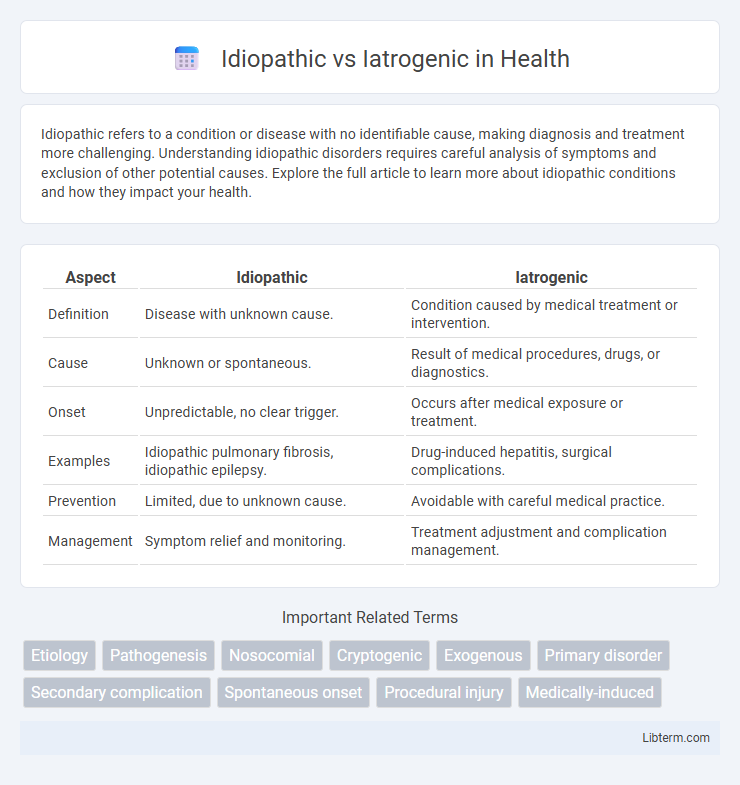Idiopathic refers to a condition or disease with no identifiable cause, making diagnosis and treatment more challenging. Understanding idiopathic disorders requires careful analysis of symptoms and exclusion of other potential causes. Explore the full article to learn more about idiopathic conditions and how they impact your health.
Table of Comparison
| Aspect | Idiopathic | Iatrogenic |
|---|---|---|
| Definition | Disease with unknown cause. | Condition caused by medical treatment or intervention. |
| Cause | Unknown or spontaneous. | Result of medical procedures, drugs, or diagnostics. |
| Onset | Unpredictable, no clear trigger. | Occurs after medical exposure or treatment. |
| Examples | Idiopathic pulmonary fibrosis, idiopathic epilepsy. | Drug-induced hepatitis, surgical complications. |
| Prevention | Limited, due to unknown cause. | Avoidable with careful medical practice. |
| Management | Symptom relief and monitoring. | Treatment adjustment and complication management. |
Understanding Idiopathic and Iatrogenic: Key Definitions
Idiopathic refers to medical conditions or diseases with unknown causes, where diagnosis relies heavily on symptom analysis and exclusion of other factors. Iatrogenic describes health complications directly resulting from medical treatment or diagnostic procedures, often linked to physician intervention or hospital care. Differentiating idiopathic from iatrogenic conditions is essential for accurate diagnosis, effective treatment plans, and minimizing preventable medical errors.
Origins of Idiopathic Conditions
Idiopathic conditions arise from unknown or unexplained causes, with origins that remain elusive despite extensive medical evaluation and testing. These disorders differ from iatrogenic conditions, which stem from complications of medical treatment or interventions. Understanding idiopathic origins helps guide research efforts toward identifying underlying mechanisms and improving diagnostic accuracy.
Causes and Mechanisms of Iatrogenic Disorders
Iatrogenic disorders result from medical intervention, such as adverse drug reactions, surgical errors, or infections acquired during treatment, distinguishing them from idiopathic disorders, which have unknown causes. The mechanisms of iatrogenic conditions often involve toxicity, procedural complications, or immune responses triggered by therapeutic agents. Understanding these causes is essential for developing preventive strategies and improving patient safety in clinical practice.
Diagnostic Challenges: Idiopathic vs Iatrogenic
Distinguishing idiopathic from iatrogenic conditions presents significant diagnostic challenges due to overlapping clinical symptoms and the lack of definitive biomarkers. Idiopathic disorders lack identifiable causes, complicating the attribution of symptoms, whereas iatrogenic conditions arise from medical interventions, requiring detailed patient history and thorough evaluation of prior treatments. Accurate differentiation relies heavily on comprehensive diagnostic protocols, including patient history analysis, temporal correlation with medical procedures, and exclusion of alternative etiologies.
Clinical Examples of Idiopathic Diseases
Idiopathic diseases, such as idiopathic pulmonary fibrosis, idiopathic epilepsy, and idiopathic thrombocytopenic purpura, are characterized by unknown causes, presenting diagnostic challenges in clinical practice. Unlike iatrogenic conditions, which result from medical interventions or treatments like drug-induced liver injury or radiation-induced pneumonitis, idiopathic diseases require symptom-focused management and extensive investigations to rule out known etiologies. Clinical examples highlight the necessity for ongoing research to uncover pathophysiological mechanisms underlying idiopathic disorders to improve therapeutic outcomes.
Common Iatrogenic Complications in Healthcare
Iatrogenic complications in healthcare commonly include medication errors, infections acquired during hospital stays, and surgical injuries. These adverse effects result directly from medical interventions rather than underlying disease, distinguishing them from idiopathic conditions, which have unknown causes. Understanding and minimizing iatrogenic risks are crucial for improving patient safety and reducing healthcare-associated harm.
Risk Factors for Idiopathic and Iatrogenic Conditions
Risk factors for idiopathic conditions often remain unknown due to their spontaneous and unexplained nature, making diagnosis and prevention challenging. Iatrogenic conditions result from medical interventions, with risk factors including invasive procedures, medication side effects, and hospital-acquired infections. Understanding these distinctions helps healthcare professionals minimize patient harm by identifying and mitigating risks associated with treatments versus unknown disease origins.
Prevention and Management Strategies
Idiopathic conditions, with unknown causes, require preventive strategies focused on general health maintenance and symptom monitoring to manage disease progression. Iatrogenic conditions result from medical interventions, necessitating prevention through careful procedural protocols, accurate dosing, and vigilant post-treatment surveillance. Effective management of both involves personalized care plans, early detection of complications, and multidisciplinary collaboration to optimize patient outcomes.
Ethical Considerations in Iatrogenic Cases
Iatrogenic cases, caused by medical intervention, often raise significant ethical considerations related to patient consent, transparency, and accountability in healthcare. Ensuring informed consent requires thorough communication about potential risks, even when procedures are generally safe, highlighting the ethical duty to minimize harm. Healthcare providers must balance the principles of beneficence and non-maleficence while addressing iatrogenic harm, emphasizing the need for ethical protocols and patient-centered care to maintain trust and integrity in medical practice.
Future Perspectives in Research and Clinical Practice
Future perspectives in idiopathic and iatrogenic conditions emphasize advancements in genetic profiling and biomarker identification to enhance early diagnosis and personalized treatment strategies. Integration of machine learning algorithms in clinical data analysis promises improved prediction models for patient outcomes and therapy responses. Continued interdisciplinary research aims to reduce iatrogenic complications through precision medicine, while unraveling idiopathic disease mechanisms to develop targeted therapeutics.
Idiopathic Infographic

 libterm.com
libterm.com